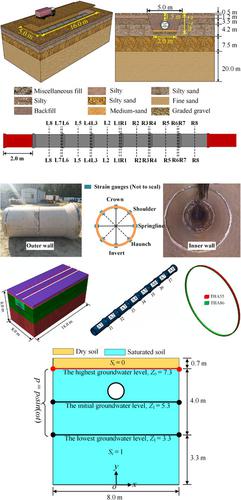当前位置:
X-MOL 学术
›
Energy Sci. Eng.
›
论文详情
Our official English website, www.x-mol.net, welcomes your feedback! (Note: you will need to create a separate account there.)
Dynamic analysis of concrete pipes under the coupled effects of traffic load and groundwater level fluctuations
Energy Science & Engineering ( IF 3.8 ) Pub Date : 2019-10-22 , DOI: 10.1002/ese3.520 Bin Li 1, 2 , Hongyuan Fang 1, 2 , Kangjian Yang 1, 2 , Peiling Tan 1, 2 , Fuming Wang 1, 2
Energy Science & Engineering ( IF 3.8 ) Pub Date : 2019-10-22 , DOI: 10.1002/ese3.520 Bin Li 1, 2 , Hongyuan Fang 1, 2 , Kangjian Yang 1, 2 , Peiling Tan 1, 2 , Fuming Wang 1, 2
Affiliation

|
Fluctuations in the groundwater level make the working conditions of concrete pipes below the groundwater level more complex than those of concrete pipes above the groundwater level. This paper describes the application of a three‐dimensional (3‐D) refined finite element (FE) model to the analysis of a buried concrete pipe subjected to the coupled effects of traffic load and groundwater level fluctuations. First, the dynamic responses of the concrete pipes buried in dry soil were investigated with a full‐scale test and an FE model. The results show that the FE model predicted results similar to those observed in field pipes. Then, the dynamic responses based on the numerical results of pipes buried in dry soil under a traffic load and those of pipes buried in saturated soil under the coupled effects of a traffic load and groundwater level fluctuations were compared. Finally, a parametric analysis of the effects of the void ratio, permeability coefficient, and fluctuation period in the groundwater level in relation to the dynamic responses of the pipes was conducted. The results show that the mechanical behaviors of the pipes in dry soil were substantially different from those of pipes in saturated soil. Compared with pipes in dry soil under a traffic load, the stresses at the crown, springline, and invert of the bell under the coupled effects of the traffic load and groundwater level fluctuations were lowered by 44.8%, 52.0%, and 50.3%, respectively, while those of the spigot were lowered by 42.0%, 50.3%, and 49.6%, respectively. The maximum principal stress and the vertical displacement were proportional to the void ratio and the permeability coefficient, while their relationship to the groundwater level fluctuation period was less straightforward.
中文翻译:

交通荷载与地下水位波动耦合作用下混凝土管的动力分析
地下水位的波动使地下水位以下的混凝土管的工作条件比地下水位以上的混凝土管的工作条件更为复杂。本文描述了在交通荷载和地下水位波动的耦合作用下,三维(3D)精化有限元(FE)模型在分析地下混凝土管道中的应用。首先,通过全面测试和有限元模型研究了埋在干燥土壤中的混凝土管的动力响应。结果表明,有限元模型预测的结果与现场管道中观察到的结果相似。然后,基于交通荷载作用下干土埋管和饱和荷载下埋管的数值响应,比较了动力荷载和地下水位波动共同作用下的动力响应。最后,对孔隙度,渗透系数和地下水位波动周期与管道动力响应的关系进行了参数分析。结果表明,在干燥土壤中管道的力学行为与在饱和土壤中管道的力学行为有很大的不同。与交通负荷下的干土管道相比,在交通负荷和地下水位波动的共同作用下,树冠,钟形线和铃铛的应力分别降低了44.8%,52.0%和50.3%。 ,轴颈的下降分别为42.0%,50.3%和49.6%。最大主应力和垂直位移与孔隙率和渗透系数成正比,而它们与地下水位波动期的关系则不太直接。
更新日期:2019-10-22
中文翻译:

交通荷载与地下水位波动耦合作用下混凝土管的动力分析
地下水位的波动使地下水位以下的混凝土管的工作条件比地下水位以上的混凝土管的工作条件更为复杂。本文描述了在交通荷载和地下水位波动的耦合作用下,三维(3D)精化有限元(FE)模型在分析地下混凝土管道中的应用。首先,通过全面测试和有限元模型研究了埋在干燥土壤中的混凝土管的动力响应。结果表明,有限元模型预测的结果与现场管道中观察到的结果相似。然后,基于交通荷载作用下干土埋管和饱和荷载下埋管的数值响应,比较了动力荷载和地下水位波动共同作用下的动力响应。最后,对孔隙度,渗透系数和地下水位波动周期与管道动力响应的关系进行了参数分析。结果表明,在干燥土壤中管道的力学行为与在饱和土壤中管道的力学行为有很大的不同。与交通负荷下的干土管道相比,在交通负荷和地下水位波动的共同作用下,树冠,钟形线和铃铛的应力分别降低了44.8%,52.0%和50.3%。 ,轴颈的下降分别为42.0%,50.3%和49.6%。最大主应力和垂直位移与孔隙率和渗透系数成正比,而它们与地下水位波动期的关系则不太直接。



























 京公网安备 11010802027423号
京公网安备 11010802027423号